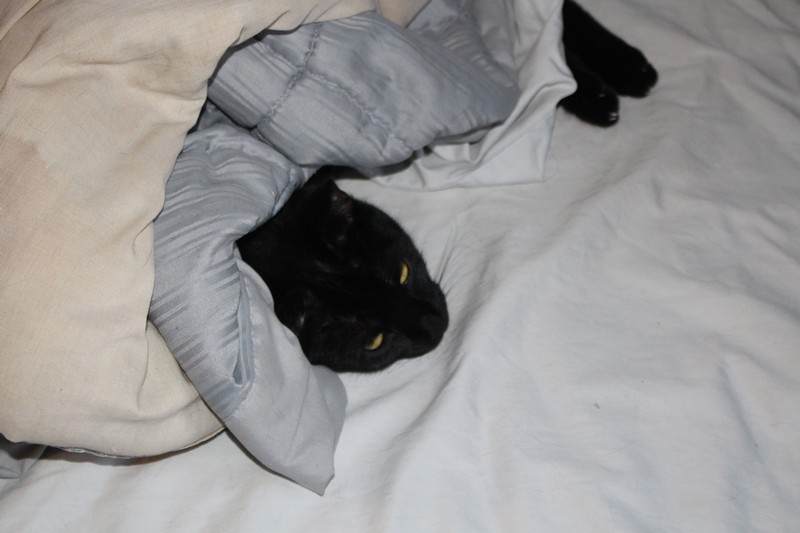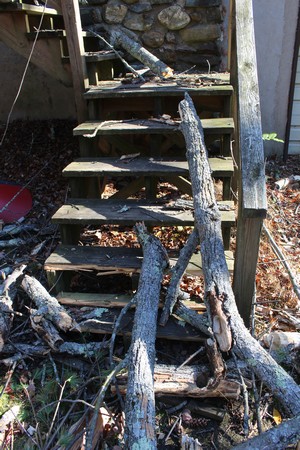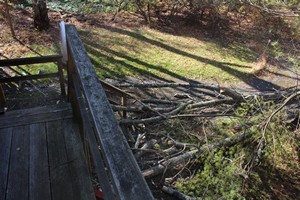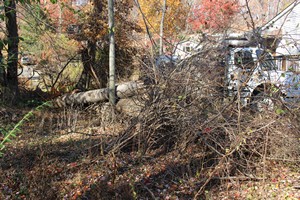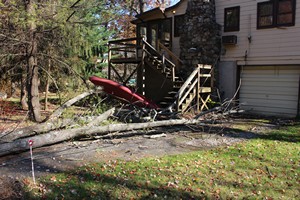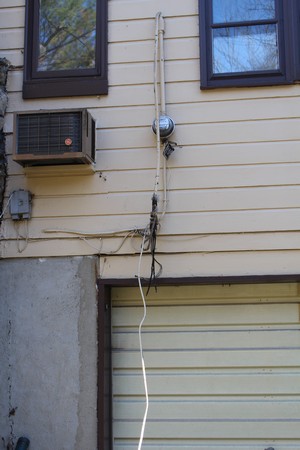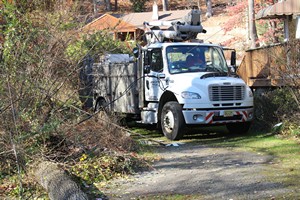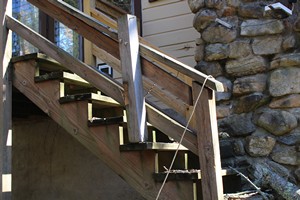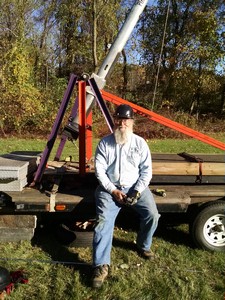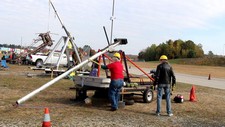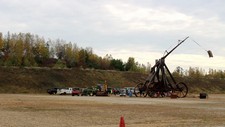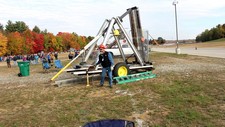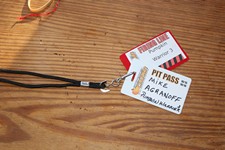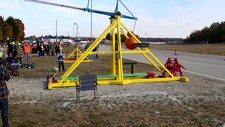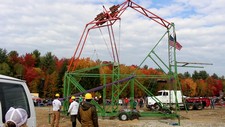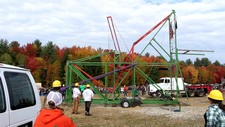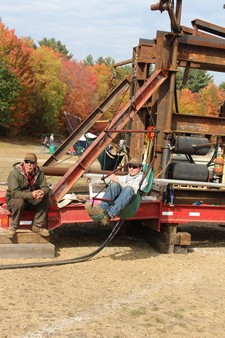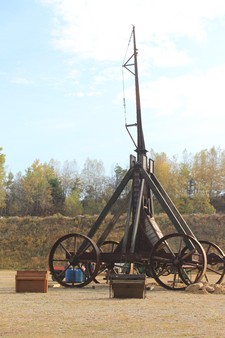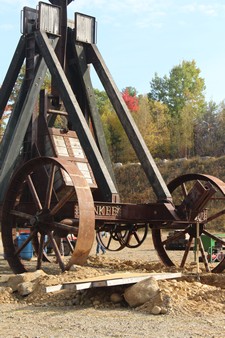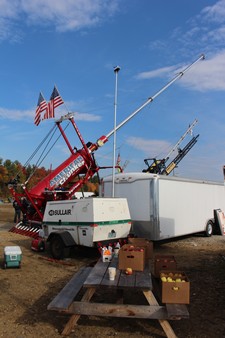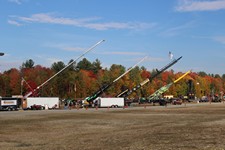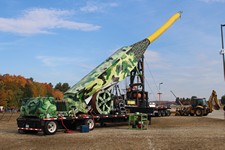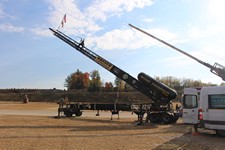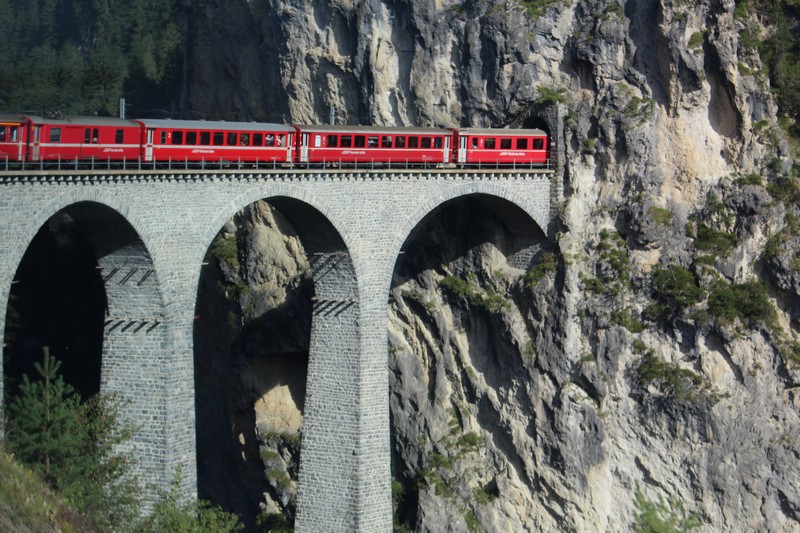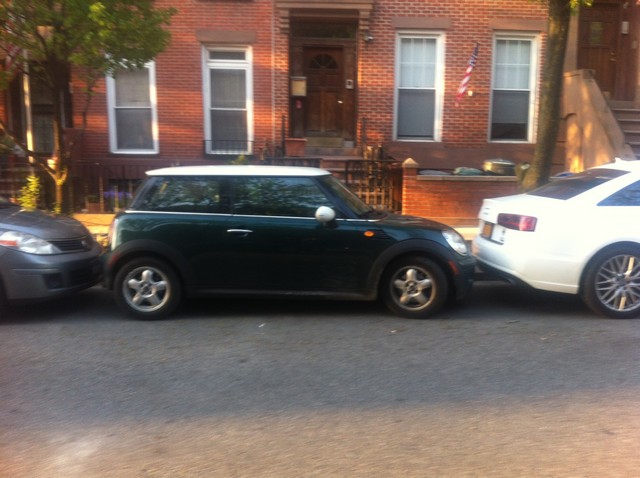November 29, 2016
Random Act of Senseless Courtesy
I had the occasion to be in New York City on the Sunday after Thanksgiving. I had gone into the City over the weekend to go dancing and visiting, and attend a Bach Vespers service in the Evangelical Lutheran Church of the Holy Trinity on Central Park West. Now I was born and bred in that Great Big Briar Patch, Br'er Fox. And while I haven't lived there in decades, it's still easy to fall into the rhythms and mindset of the New Yorker when I'm back there. So when I left for home, it felt perfectly normal to head down into the subway to take the C-Train down to the Port Authority Bus Terminal at the 42nd street station to catch the bus back home to New Jersey. (Although the process of buying a $2.75 Metro-Card with a credit card at a machine instead of a 15 cent token from an attendant at the booth was a little outside my comfort zone.)
I was sitting in the station, waiting for the train, and ignoring everyone else around me like any good New Yorker, when a porter who was cleaning the platform passed in front of me. He unlocked the trash receptacle right next to my bench, and started to empty the inner can. (The only place I've ever seen where they have to lock up the trash cans.) He was a large black man, looking to be in his 50s, working his job on a Sunday evening, and minding his own business.
Then I don't know what came over me. I stood and addressed him thus: "Excuse me, sir. Would I be revealing myself as a hopeless out-of-towner if I said 'Thank you.'?" It took him aback for a couple of seconds. And then he gave a hearty chuckle, and said "No". And then, almost as an afterthought, he smiled and said, "You're welcome!"
I bet he had something to tell the wife when he got home that night.
November 6, 2016
A Tree Falls in Boonton
So I was sitting in my home office on Saturday morning, getting ready for a gig in the evening, when the house shook to the sound of a loud thump/crash, and my emergency backup generator cranked into life. I went out to look, and discovered a large tree on my property had come down across my driveway, ripping my electrical power line off the meter outside my house. It wasn't particularly windy, or anything. The tree was a triple trunk ash, and two of the trunks had rotted at their base, and fallen The third trunk remained standing, but dead, and leaning slightly towards the house next door. The tree had also ripped the electrical power cable off that neighbor's house as well as mine. This would require some attention.
What was particularly scary was that another neighbor, who is a landscaper, was in the process of clearing leaves off the lawn of the house next door, and had driven his tractor right where the tree had fallen only a few minutes earlier. The tree had done some superficial damage to my outside stairs and the electrical connection to the outside wall of my house where the electrical service entered the meter. Remarkably, my internet/phone cable, while pulled to the ground along with the electrical cable, still remained connected, and my phone, email, and internet service remained uninterrupted. I called the electric company, and informed them of the downed wires.
The electric company truck was on the scene in about an hour, and shut off the power to the downed cables. They were able to re-establish the connection to my neighbor's house, but there was too much damage to my electrical connection for them to be able to reconnect me. I made one more call to yet another neighbor (I have useful neighbors!) who works for a tree service, and he and his boss came by a couple of hours later to clear the tree from my driveway, and take down the dangerous trunk that had not fallen. I called an electrician, and arranged for him to come and repair the damage to my electrical service connection on Monday. Meanwhile, the generator has been running, and providing my house with power quite nicely. It's been 24 hours, and I've used up about 1/6 of my remaining propane fuel supply. I've called my home insurance company, and I'm covered for the damage, but not for the removal of the standing trunk. And I have enough firewood now to last me well into the 2017 / 2018 heating season. I think I'll get through this quite handily. (Click on any photo to view it in full screen.)
October 16, 2016
Punkin Chunkin
So what's "Punkin Chunkin"? It's something I had encountered from time to time over the past few years while channel surfing, usually on Discovery or the Science Channel. It's a competition / hobby / obsession amongst a small bunch of engineers and fanatics and grown up children with entirely too much time on their hands (and I say that with all the respect and love I can muster) to build mechanical devices to hurl pumpkins through the air as far as possible. While not exactly a rabid fan, I did watch little segments of the show as the engineer in me entertained the mechanical challenge of the task.
According to Wikipedia, "Pumpkin chucking competitions, formal and informal, exist throughout the United States in the autumn, and often occur when pumpkins are harvested. World Championship Punkin Chunkin, held annually in November in Delaware by the World Championship Punkin Chunkin Association (WCPCA), was the first and largest annual competition, most often held in Bridgeville, Delaware. The event began in 1986, and in 2010 featured over 100 teams, but in 2014 and 2015 it was not held due to logistical problems as its future had become uncertain, which seem to have been settled for the...2016 event [was] held in Bridgeville. A European Championship has been held in Bikschote, Belgium each year since 2004."
I had never entertained the thought of actually attending an event. But back in January, a fan of mine, Bruce Strong, came up to me after a performance, and invited me to come as part of his team. I thanked him, and pretty much forgot about it until he sent me a reminder of his invitation about a month ago. There were two dates he proposed: one in Loudon New Hampshire on the weekend of October 21-22, and the World Championship in Delaware on November 5-6. I had gigs on the November weekend. But I had thought about going up to visit my brother Saul in Waltham sometime in October. So I proposed the outing to Saul, and we made a date.
Extreme Chunkin'. New Hampshire Motor Speedway, Loudon, NH, Oct. 16, 2016
(Click on any photo to view it in full screen.)
|
|||
|
The location was the New Hampshire Motor Speedway in Loudon, NH, about 90 minutes drive from Saul's house. We decided to attend on Sunday the 22nd. The schedule for the day was some preliminary demonstration throws in the morning, followed by a competition round from 9:00 to noon, and then some more demos, and what they called "free-fire": a chance to throw for fun and for experimentation with the adjustments on the machines. We arrived around 9:30, but weather had delayed the start of the competition (ground fog), so we hadn't missed anything. The competition machines were all lined up along the side of what must be a parking lot for the Speedway. There were four kinds of machines represented in the competition:
Bruce met us at the gate when we arrived, gave us our credentials, and escorted us to his machine, the Pumpkin Warrior 3. It was a catapult, powered by a bank of 20 oversized garage door springs. It was small enough to be towed behind a pickup truck, which made it a pigmy compared to some of the other machines that were so big they had to be assembled on site.
As a "team member", my contribution to the proceedings of Pumpkin Warrior 3 were pretty small. I got to actually launch the pumpkin, but my contribution to the effort was about as great as that of the President when he presses the button to light the National Christmas Tree. The big advantage of being a team member was that I had access to the pit area. I could see the machines and the launches from close up, rather than from behind the crowd barrier about 100 feet behind the machines. (And as an added safety precaution, they would maneuver a chain link barrier behind each trebuchet as it launched, and not allow anybody to stand directly in line behind the barrier during launch in case a sling let go early and sent the pumpkin backwards.
I sort of knew it before intellectually, but the reality that this was no casual undertaking hit me like a half-ton pumpkin when I actually got close to the machines. The photos don't do them justice. (Except perhaps for the photo of the Yankee Siege, standing behind a couple of spinet pianos which served as its ammunition for some demo shots.) Yankee Siege is an obsolete machine, no longer in contention for any of the real competition. But it does have the capacity to throw missiles of enormous weight, such as pianos, boats, cars, and a 1,300 pound pumpkin. And after every 3 or 4 competition throws, they'd take a break from the competition and have a demo throw by Yankee Siege. It was situated at one end of the line of competition machines, and threw along the line at a miniature "castle" made of wood at a range much shorter than the competition throws. It never hit the castle, but was wonderfully entertaining. There's something of the little boy in all of us that likes to see things smashed, and Yankee Siege satisfied that something in me. They also had one of those enormous construction cranes at the other end of the line with which they would hoist up big heavy objects like cars and pianos and motorcycles, and drop them. It was so far away that it was considerably less impressive.
The man behind Yankee Siege, as well as Yankee Siege II (present, but not depicted here), Yankee Doodle and Yankee Scout is Steve Seigars, who is sort of the Grand Old Man of New England chunkin. His grand kids are the team members of Yankee Scout. According to Bruce Strong, "He is a dentist that has an apple orchard. They used to run it as a roadside farm (Greenville, NH) but I don't think they do anymore."
The one aspect of the event that put me off a bit was the announcer, who did a play-by-play of all the proceedings over a PA for the crowd. He really seemed to play up the delight of the destructive aspect of the proceedings. It's OK to take a secret joy in destruction, but when a big deal is made of it, it kind of paints the whole event with a red-neck shit-kicking "Let's get drunk and shoot up the town!" tone that I don't care for. I would have rather the play-by-play be given by one of those guys who does the voiceover for PBS episodes of NOVA, and emphasized the technical aspects of the challenge. Perhaps a bit disingenuous of me, but I can't help it.
The procedure of the event is as follows: The team of each machine in turn down the line indicates that they are ready, and then they are given 3 minutes to launch. There is a crew of spotters downrange riding ATVs with GPS devices. The launch team sounds a loud horn before launch to alert the spotters, and then launches. The spotters then have to pick up the pumpkin visually in mid-flight, and locate the landing point. (While taking care not to actually be the landing point.) They put the GPS device in the center of the splat, and radio the coordinates back to base, where they are compared with the coordinates of the launcher. They then compute the distance. The spotters' jobs must be pretty difficult, since many of them are over the ridge at the far end of the field, and cannot actually see the launch. And the ranges can vary from as little as a couple of hundred feet to as much as 3/4 of a mile, so there's a lot of territory to cover. And their accuracy is not all that good. One can visually track a spiral path on some of the projectiles as they fly. The pumpkins must weigh between 8 and 10 pounds..
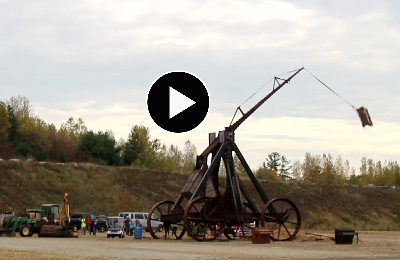
Here's a sampler of video clips of some of the machines I saw. I'll apologize in advance for the video quality. With any of the more powerful machines, it's extremely difficult to follow the pumpkin in flight by eye. Radar guns have clocked the missiles at over 400 MPH, and one has to be standing directly behind the machine to see the pumpkin launch. And even then, on some of the longer shots the missile gets too small to see before it hits the ground. So it's real difficult to follow the pumpkin's flight with the camera. To add to the difficulties, for some inexplicable reason, my SLR camera does not permit me to shoot movies looking through the viewfinder. I must rely on the rear screen, with which it is difficult to frame a shot, particularly in daylight.
Yankee Scout: This is an entry in the "Youth" division. I'm not sure of the age limitation. The rules specify that the kids handle the loading, cocking, and launch of the device, but they may have adult help in the design and construction. They also throw a much smaller 4-pound pumpkin. The crew are Steve Seigars' grand kids This was the first video I took all day, and the first launch I had seen close up. I discovered the difficulties of tracking the pumpkin using the screen of the camera, and never saw its flight. It went 491 feet for a first place in the Youth division..
Mistah Ballista: This was the only torsion entry. It was a relatively compact device. I'm told that the twisted rope bundle which powers the launch is the most compact energy storage device of any of the mechanical launchers. The ropes would take a set if the device remains cocked too long, so they don't cock it until they are "on the clock" of 3 minutes to launch. They use a hydraulic winch to draw the arms back, and the elevation angle is also adjusted by a hydraulic cylinder or motor powered by an external hydraulic pump. On this one I did manage to catch the pumpkin in the video, but as you can see it quickly disappears from sight in the distance. That shot landed well over the ridge in the background, and measured 1,233 feet for a 3rd place.
Yankee Siege launches a piano: This was one of the demo throws by Yankee Siege. The size of the launcher is truly impressive, and the counterweight that powers the arm weighs 9-1/4 tons, considering that even on the short arm of the lever, it manages to throw things as heavy as cars and pianos. Again, the difficulty of following the projectile on the rear screen of the camera caused me to lose most of its flight. But you can see the landing, and the miniature castle target, which it overshot by 20 yards or so.
Pumpkin Warrior 3: This was our team's entry. It's a catapult, powered by 20 steel extension springs 3" diameter with a max design force of 340 pounds each. They are hooked between two parallel bars, one that is part of the frame of the machine, and the other affixed to a cable that pulls on the short end of the pivot arm via a couple of pulleys. the moveable bar is drawn back by an electric winch. The arm itself is an aluminum boom from a sailboat. And the release mechanism is a "spinnaker release", a piece of sailboat hardware that is triggered by placing the end of a long pole on the release device, and whacking the end of it with a hand sledge. (My job.) You can see that at the beginning of the video, the arm is secured by a heavy-duty strap to prevent it from launching inadvertently. The safety catch. My brother took the video, and he too missed the projectile. It went 991 feet, landing just a little short of the ridge at the far end of the field. .
Dayton Destroyer: Another spring-powered trebuchet. On this one the springs are arranged vertically attached directly to the throwing arm, rather than by a cable to the arm. It threw 851 feet, but managed 894 feet the previous day.
Launch Ness Monster: This was my favorite machine at the event. The announcer described it as looking like a carnival ride collapsing into itself, and somewhere in the process, a pumpkin comes flying out of the middle of it. It was a rather elaborate mechanism designed to maximize the velocity of the sling at the point of release. It was designed by a bunch of engineering students. The description proved apt, as you can see by the video. The results of this launch were, what is referred to in the trade as "pie". Short for "pumpkin pie in the sky". The pumpkin disintegrated upon launch from the acceleration forces applied to it. But threw 2,644 feet the previous day. There's a really nice slow-motion video of a throw on YouTube.
Tired Iron: A more conventional (if that word is applicable) trebuchet powered by a heavy counterweight on the arm. But the counterweight is constrained by a couple of vertical tracks to fall straight down instead of following the arc of the throwing arm, while the pivot moves horizontally on wheels to compensate for the changing horizontal distance between it and the tracks as the arm swings through its arc. That causes the pivot to be moving forward at the time of release, imparting more horizontal velocity to the projectile. I love the "industrial" look of the enormous heavy I-beam frame, like that of Yankee Siege. It threw 1,586 feet, but took a 2nd place with a 2,972 foot throw the previous day
Yankee Siege launches a sailboat: That's not the way most people would launch a sailboat.
Yankee Doodle: This was the only air-cannon launcher I filmed. Unlike the mechanical throwers, there are no obvious moving parts. All that happens is that it emits a big whoosh, and a cloud of water vapor out of the muzzle. The muzzle velocity of the pumpkin is really too great for one to follow the missile by eye. The throws are impressive in their distance numbers, but there's not much to actually see or film. I can imagine the biggest problems are in the design of the valve that releases the air. The air tank looks to be made from a 400 gallon propane tank, and one of the crew told me they use pressures between 200 and 300 PSI. And all that air gets released in a matter of a second or so. It doesn't show in any of the photos, but the inlet pipe from the tank to the chamber behind the pumpkin was something like 14" in diameter. It threw 3,176 feet, but managed 3,528 feet the previous day. First place in the Air Cannon division was American Chunker at 4,191 feet.
August 29 - September 9, 2016
The Alps By Rail
I've just returned from a wonderful, but exhausting vacation, taking a rail tour through the Swiss and Italian alps. It was a package vacation arranged by Collette Tours with 34 other Americans and Canadians. We stayed 2 nights in each of 4 cities, seeing the sights in each city, and travelling by rail and motorcoach between them. Lots of mountains, rivers, tunnels, and bridges. And lots of photos and videos of them. Click on the photo above to enter the travelogue.
August 21, 2016
Philadelphia Folk Festival Campground
I just got back from the Philadelphia Folk Festival. I had a good time, but it was pretty exhausting (as usual). The weather was oppressively hot and humid (as usual). I had two appearances, a showcase concert on Saturday and a "Squeezebox" (I hate that term) workshop on Sunday. It rained throughout my Sunday performance, so I played to a crowd of nearly several. I was a little concerned about being onstage with Sharon Shannon, who is a brilliant button accordion player who was flown over from Ireland specifically for the Festival. But, I held my own with a performance of my 2-concertina transcription of the first movement of Bach's 3rd Brandenburg Concerto. (I play the 1st Concertina part live against a recording of myself doing the 2nd part, plus a cello and bass viol.)
I had a bit of an adventure on Friday night. I arrived on site on Friday around 1:00 PM, stayed through the end of the evening concert, and then went to cruise the campground. For about 20 years, I had been hired by the Festival as a songleader around the Fire Circle in the campground, and I like to spend at least one late night cruising the campground and renewing old acquaintances. So around 2 in the morning, I decided to call it a night, and head back to the hotel, which is about a 45 minute drive from the site. I was quite tired, and got lost twice on the route back: once on the twisty two-lanes around the Festival site, and once at a spaghetti intersection between two interstates. But I finally made it to the Fort Washington Holiday Inn. I drove around back to park, and suddenly I was in an alternate universe. The back entrance wasn't there. I went around to the front, and it was an entirely different hotel than the one I had stayed in the past 20 years. The people at the front desk knew nothing of any Festival performer housing.
Did I go to the wrong hotel? I looked at Google Maps, and there was another Holiday Inn in Norristown. I called them, and they knew nothing about a Festival either. By now it was a quarter after 3. Whom do I call at this hour? Thank goodness I had my computer with me. I opened it up and went to look at the welcome letter I had received from the Festival. Sure enough, last year, when I couldn't attend the Festival because of my injury (See my August 3rd, 2015 Blog Entry, Big Fall) they had changed hotels to the Holiday Inn, Lansdale, some 20 miles closer to the Festival site. (The Fort Washington Holiday Inn, meanwhile, had undergone significant renovations, resulting in my confusion when I had arrived there.) I called them up, and sure enough, that was the right hotel. It was about 4:00 by the time I finally hit the rack. I got up early the next morning, went out to the site to play my concert, and then came back to the hotel and caught some more sleep.
On Sunday, I went out to the campground again to see it in daylight. And it struck me what a colorful place it is. There's a story I tell about my experience one year when a fellow chose to play the bagpipes right behind my tent at 7:00 in the morning, and it gives some verbal picture of the campground. But I had never thought until that moment to take some real pictures. I did the best I could with my phone. Maybe next year I'll bring a camera.
Scenes from the Philadelphia Folk Festival Campground. (Click on any image for an enlarged view.)
|
|||
|
|||
|
|||
|
June 18, 2016
No More iPads, No More Books
Maybe it’s a cultural thing. Maybe it’s a generational thing. Maybe it’s the Internet. But there seems to be a profound change in the way people approach playing music in jams and song circles these days from when I first got into folk music. Used to be that someone would hear a song he liked, sit down and learn it, and then go to the singing session and play it. Today it seems, people don’t bother with that 2nd step.
With the lyrics to any song that has ever been published instantly available at the tap of an iPad, people are no longer bothering to learn them. The Internet has opened up an infinite repertoire for anyone to sing. Or at least that’s the common opinion. More accurately put, they now have an infinite repertoire of songs to sing badly.
I find it painful to listen to an otherwise good musician stumbling his way through a song he doesn’t know with no preparation. They often wind up fumbling for chords and words, messing up the scansion (Does the line begin on the upbeat or the downbeat?), absolutely bereft of expression and feeling, and with eyes glued to the screen instead of on his listeners. I know this person could do better, much better if he just put a little work into it beforehand.
“So what?”, you say. “It’s a jam, not a performance.” Well here goes, and I’m sorry if I ruffle a few feathers. Jam, round robin, performance, or whatever...You’re doing a disservice to the song. The music itself deserves better of you than that. And you probably have it in you to do better.
At least I think you do. I have a question to those of you who “sing” from the iPad. Do you ever put in any preparation or practice before you trot out a song to sing at a song circle? Do you ever try to learn the song before presenting it in public? How long do you spend on it at home first? At the risk of sounding like an old fart, when I first started attending music parties and song swaps, there was not a lyric sheet to be seen in the room, even from the most rank beginners. Learning a song was an integral part of playing it.
Here’s an experiment for you iPad singers to try. Pick a song you really like, and spend an hour or two actually learning it. Learning it so you can sing it with no hesitation. Put in 15 minutes a day, learning one verse at a time. Get it down cold. Then come to a jam, shut off the iPad and just sing it. Sing it for the others around you, but more important, sing if for yourself. And for the song. You’ll find it so much more satisfying. And so with those around you.
In the interest of full disclosure, I must report that while this sentiment is truly from my own heart, the expression of this sentiment was highly influenced by (and in one instance cribbed directly from) an article written by Ian Robb in the May/June 1993 issue of Sing Out! Magazine. Only Ian’s displeasure was directed at the singers’ use of the song book, Rise Up Singing, which had just been published a few years before. I remember reading that article, and when finished, standing up all alone in my living room and applauding. The more things change, the more they remain the same. I have given a workshop at various festivals called “Putting Away The Book, Techniques of Memorizing Songs”. And I open that workshop by reading aloud the highlighted parts of that article
May 4, 2016
Uncle Albie
You never know where things will lead. I've been keeping this blog since 2001, but few people knew about it. So last week I sent out an invation to my mailing list to subscribe to the Blog. And one of the respondants was my cousin Lois in Michigan, with whom I've corresponded sporadically, but haven't seen since childhood. I asked about her dad, my mother's brother Albie, whom I hadn't seen since he served as my mom's caretaker when she was dying in 1993. I figured he was long dead. Au contraire. He is alive and kicking, and still living with his girlfriend Nydia in the same house in Brooklyn where I used to visit him as a kid. So I gave him a call to catch up.
Uncle Albie is still with us and still with it at age 96. He has slowed down a little since a hip replacement, but in his day he was quite an athelete. And his day was very long. He ran something like 25 marathons, the last of which was 15 years ago at the age of 80. When he was in college at CCNY, he scored what was at the time (and may be still) the longest basketball shot ever recorded in Madison Square Garden from the foul line at the opposite end of the court. He was a high school gym teacher, and retired at age 79 as a principal in one of the roughest high schools in Bedford Stuyvesant. He's still driving (!) and says he may come out to see me when I play the Crossroads Festival on Long Island on June 12. I sure hope he makes it. I want to shake his hand and hope I inherited a few of his genes. Alas, he won't get to read this, as he doesn't own a computer.
Lois, send your dad a copy of this, and tell him I said nice things about him.
April 24, 2016
I Still Got the Knack!
Last night I went to Ken Schatz's "Exceedingly Good Song Night". EGSN is a wonderful singing session in New York City. Takes place twice a month, once in Manhattan at Jimmy's on East 7th Street off 2nd Ave, and once in the Jalopy Tavern in Brooklyn. This was my first time in the new Brooklyn location, and coincidentally, the 100th EGSN session. It was less convenient to get to than the Manhattan location, but I wanted to see what it was like. I arrived and started looking for parking places. I went half a block, and saw a very small spot. But I have a very small car, and judged I could fit. Turned out I could.
On the first attempt.
With a clearance of about 2 to 3 inches at each end.
Born and bred in that Briar Patch, Br'er Fox! I grew up, and learned to drive in NYC.
January 23, 2016
An Adventure In the Snow
So yesterday, we had a nor’easter that left a near-record 30 inches of snow. I had parked up at the head of the driveway, and this morning spent about an hour and a half shovelling a footpath down my 200 foot long driveway to reach my car to get it out of the way for the guy with the plow to finish the job. With that done, I figured I’d collapse in front of the AFL final between the Patriots and the Broncos.
I was just finishing dinner, and put the dish down for my cat Keira to clean, when I realized…No Keira. Where's Keira? I called through the house, opened the closet doors and the garage door. No Keira. Oh, that's right. She was yammering at me to let her out, and so I did. At the beginning of the football game. At 3:00.
Keira has never experienced snow.
Until now.
And now she had two and a half feet of the stuff to experience.
I got out my flashlight and put on a sweater and went out into the darkness and called. And listened. And heard, or at least imagined I heard a tiny peep. A chirp. A something that was the same pitch as Keira's call. There was nothing to do but wade into knee-high snow in the direction of the imagined sound. Stop again. Call again. Yes, there's the reply, and it's louder. Stumble some more, call some more, listen some more. And repeat. Yes. And it's over there. Who says my hearing is going?
Direction is deceiving, but with many re-tracings I finally got close enough to recognize her mew. And there she was, in the hollow under the bole of a fallen tree. The only place she could find that was free from snow. She was unhurt, but unwilling to leave her refuge, despite cold and hunger and the call of my voice, if it meant setting foot in that dreaded snow again. The entrance to her foxhole lay crisscrossed with dried briars of some sort, but I barged my way through them, coaxed her to a point where I could grab one of her forelegs, and hauled her out. She didn't fight me, and allowed me to carry her back to the driveway, where I put her down. Her refuge was maybe 30 or 40 feet from the driveway, but I had slogged through the snow many times that distance trying to pinpoint her via sonar. She scampered back to the house. I followed, more drenched and bedraggled than she, and much more slowly.



